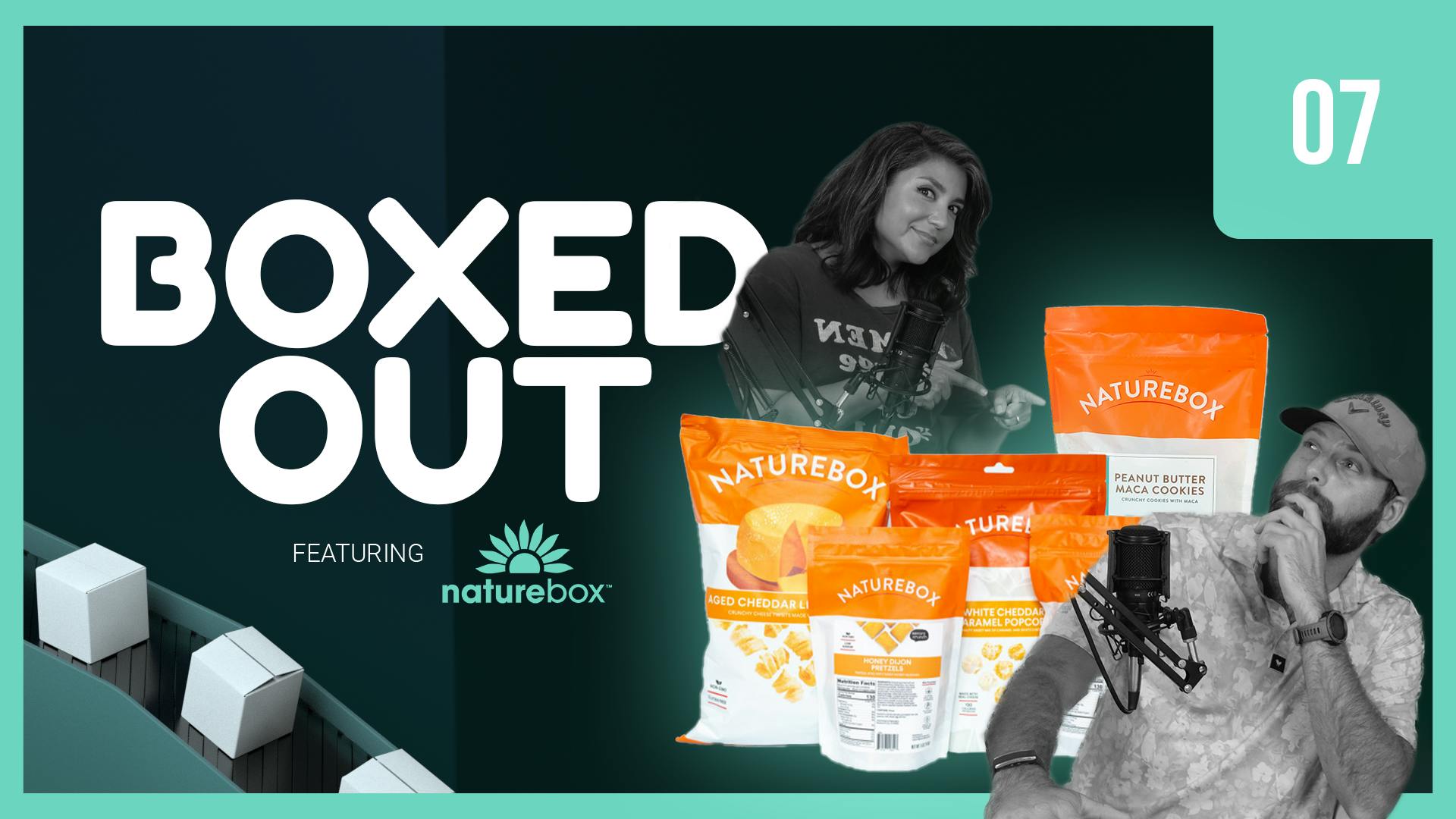
Thrive Market—thriving or withering?
This episode might reference ProfitWell and ProfitWell Recur, which following the acquisition by Paddle is now Paddle Studios. Some information may be out of date.
Please message us at studios@paddle.com if you have any questions or comments!
Today we're talking about Thrive Market, a company that's revolutionized the subscription food market. We're going to learn how Thrive Market utilizes unique positioning to stand out in a crowded space. Then we'll jump into what they're doing great—and not so great—with their subscription retention strategy, wrapping this all up into a nice case study for improvements for your own brand.
Thrive Market's mission—to eat healthy without breaking the bank—has resonated with more than a million members. Not only have they made healthy food more accessible, but they're giving back by helping families in need. But is that enough to keep those members long term?
Key takeaways:
- Free gifts and a solid customization flow go a long way Learn something about your customer in the onboarding to help not only convert them, but also keep them around for the long term. Include a free gift and you have a massive recipe for loss aversion.
At minimum, ask two to three questions to identify which type of persona they are and then offer something nominal for the free gift. It doesn’t have to be expensive—data shows that a free gift increases retention by 10-15% when compared to those customers who came in without a free gift. Average order value also jumps 20% for these customers. - A smooth cancellation flow decreases churn
Offer smooth offboarding with a one- to two-question survey on why a customer is leaving, leading to a salvage offer or pause plan. It’s not a lot of friction, but it’ll reduce some churn and not hurt the long-term possibility of reactivations.Companies that properly offer salvage offers and a clear offboarding experience tend to save 15-30% of cancellations. - Thrive needs to upscale their credit card failure process
When a credit card fails or declines, include an intelligent email drip campaign based on the customer's behavior. Include the following:
Four to five plain text emails (these aren’t sent when a credit card gets back on file).
SMS messages in this flow
Liven up the credit card form to properly capture the customer back in a more secure and pleasing way.
Thrive Market
In the age of the internet, where information is at your disposal, it's never been easier to investigate what's in your food. This has led to a new era of accountability, and to consumers expecting only the best. With consumers becoming more informed, and therefore more health conscious, this has meant that many are choosing to go organic.
Organic food is described as food that is grown to meet specific USDA requirements. These requirements are mainly environmental, and centered around natural substances and the conservation of resources like water and soil. And because of these stricter guidelines, organic food comes with a higher price tag—anywhere from 7 to 82% more expensive than conventional food. It’s no wonder the global organic food market is expected to reach $380.84 billion by 2025.
This higher price tag, however, makes organic food less accessible to many. And Thrive Market—an ecommerce membership-based retailer offering natural and organic food products at wholesale prices—is changing that.
Thrive Market was founded in 2014 by Nick Green and Gunnar Lovelace and, from the outset, has been an incredibly mission-driven company. Lovelace is a Latino immigrant who grew up poor. He and his single mother worked on an organic farm his entire life, a history that collectively made him want to "do something about limited access to healthy foods." The pair teamed up with Sasha Siddhartha and Kate Mulling to craft Thrive Market—an e-commerce food subscription service that would allow members to easily shop, afford, and enjoy healthy, non-GMO grocery staples.
Despite the passion and vision backing the Thrive Market business plan, Lovelace and Gunnar faced a huge challenge in getting it funded. They were rejected by over 50 venture-capital firms and were forced to get very creative with their crowdfunding. In the end, they formed connections with everyone from Jillian Michaels to Will Smith, coming up with $141 million through large individual and corporate donations. The company became the largest online retailer of exclusively non-GMO products within its very first year of operations, and is now frequently described as "Costco meets Whole Foods."
Thrive's success
The value of a Thrive Market membership comes through their lowered food costs. This is a crucial and primary part of their appeal, as health-based foods are notoriously more expensive and less accessible than alternatives. But, also part of their appeal is the company's "Thrive Gives" program that helps address the needs of lower-income families. For every paid membership, Thrive Market donates a membership to a U.S. family in need. This mission-backed business model is a huge part of their success. Not only do you get access to affordable, healthy foods, but you’re also helping those in need.
For $5 a month, Thrive Market members get access to over 6,000 curated products, advertised as 25-50% less expensive than standard retail prices. This vast collection of food is primarily non-GMO, ethically sourced, and organic. For added convenience and customization, the inventory is also sortable by around seventy different diets, lifestyles, or allergy needs. Navigating their stock is easy, and it isn't too hard to fill your cart with the $49 worth of product to access free shipping.
Your box of groceries is shipped directly to your home, on a schedule that you choose. You can place an order when you’re ready to re-stock your kitchen or can have certain favorites delivered on a regular basis. And you can easily skip, cancel, or delay a delivery.
Thrive Market's home page shares a simple fact: Healthy groceries shouldn't break the bank. And its vast membership—now more than one million people—is proof that they have what it takes to thrive in this market.
Retention Review
Not everything's amazing about Thrive Market’s strategy—but there’s still a lot to learn from them. They do a great job at appealing to the niche part of the market and expanding that niche steadily. That being said, we need to remember: retention is key and an area where most brands mess up.
Why is retention important?
You spend half of your budget and time acquiring customers, but to be successful, you need to keep them. The beauty of the subscription model is that the relationship with the customer is baked directly into how you make money. If that customer is happy, they'll keep buying from you in the long term. If they're upset or not seeing the value, they'll cancel—quickly.
Plus, money talks here. Subscription ecommerce companies using the tactics we're going to talk about have 2x the customer lifetime value (LTV), 2x the average order value, and 3x higher growth rates, because they're not worried about plugging a leaky retention bucket.
To highlight the importance here, let's look through Thrive Market's retention strategy and break down what they're doing well, and not so well, so you can learn for your own DTC business.
Retention has three parts:
- Active churn, which are customers who are actively choosing to cancel your product.
- Expansion revenue, which are your existing customers that buy more product.
- Delinquent (or involuntary) churn, which are customers who's credit card or payment has failed, which sadly is one of the largest single buckets of where you're losing money.
Active Churn
When we look at Thrive's active churn, there are so many reasons why a customer may cancel—some you can control, others you can't. We want to make sure Thrive is not only setting up their customers for long-term retention in the initial purchasing process, but that they're also collecting information on why someone's cancelling, if they so happen to, in order to get a clean cycle of retention improvement.
Thrive Market actually did an okay job dealing with their Active Cancellations. I like their strong customization flow, which gets me bought into not only what I’m purchasing, but allows them to show me what will most likely get me to convert and stick around with the product.
There’s so much to learn about your customer and many end up leaving because you don’t connect them with the right selection. Curated box companies should take note. A really clever tactic they use in this flow is a free gift, too. They lock me into loss aversion and we’ve actually noticed that gifts can help with retention and AOV. Those companies utilizing them typically see 10-15% higher retention and 20% higher AOVs.
Their term optimization was also great here. For those who don’t know, customers on quarterly or annual plans tend to have 2-3x higher lifetime value. Thrive pushes this annual membership as core to the experience to keep customers buying into the long term. One trip up here is to remember to push these longer term plans AFTER the initial purchase, as well. Most customers need to see your value at least on that first order before they’re ready for a long-term commitment.
One area Thrive was really lacking was in the cancellation flow. When I went to cancel, they had great messaging where they told me about my lifetime savings and how my membership helps others. This is fantastic; however, then they make you call or chat with them in order to cancel. The support is 24/7 and the representative did ask for feedback and presented a salvage offer to keep me around. Yet, this level of friction never pays off in the long run, because companies with this type of off-boarding tend to have very poor customer reactivation rates, even if their short-term cancellation rate is a bit lower.
Remember sometimes cancellations are about timing. You should add a little bit of friction with an off-boarding flow that asks why someone’s cancelling to learn from that data and then offer them different options to stick around or pause their subscription. They may still leave, but because of the good experience more of these customers will come back.
Expansion Revenue
Expansion revenue is crucial, because your existing customers are more than willing to buy 3x more from you—you just have to make sure to ask. Plus, those customers who have at least one add-on or additional purchase tend to have 18-54% higher lifetime value, meaning they're paying you more over the life of the subscription, but they're also sticking around longer, because they're more ingrained within your product.
Thrive Market’s Expansion revenue strategy was pretty great. First, as mentioned before, their customization flow is phenomenal. I love how they get my input before they ask me for options. The options offered are based on what I like and don’t like, tailoring a unique experience and making me more likely to purchase these add-ons. It does get a little repetitive, but before I know it, my cart is full.
A big thing for you to take away from this is to learn something about your customers up front. You think it’s going to cause friction in the conversion, but it actually gets me ingrained and I purchase more.
Additionally, the Thrive Cash option is a great accelerant to this. With Thrive Cash, I get credits for future purchases every time I make an order. This gives me more incentive to buy, as they can remind me through emails that I have this cash that NEEDS to be spent. It’s extremely clever and most brands mess this type of offering up by using a basic, but somehow convoluted point system. Make it simple, give people actual cash to spend on your site and they’ll come back and spend more.
Their autoship option is also very clever. With autoship I not only instantly save 30% by signing up, but I’m also more likely to stay with Thrive long term, because they’ll simply just keep sending me goods I probably won’t tire of. I don’t have to think about when I want my box to ship so that friction is immediately removed. This makes autoship not only great for Thrive’s Retention but for their revenue as well.
Credit Card Failure
Now let's talk about the sexiest topic in the world—credit card failures. We know you don't wake up sweating in the middle of the night thinking about credit cards—that's our job—but here's why we obsess over things like this: just under 40% of the customers that leave you are leaving you because of failed payments. To get these folks back, we want to make sure Thrive Market is treating these folks like a marketing channel, sending them messages before the point of failures, all the way to after the point of failure through email and text messages.
This is where Thrive, like most brands, needs a good amount of work. They need to make sure they’re shipping four to five plain text emails that appear as if they’re coming from a person rather than anything markety and over designed. Plain text works much better than HTML, markety emails, because they build reciprocity. The customer who feels obligated to respond, or at the very least not ignore the problem and just archive the email—especially if you include the value messaging Thrive is so good at in their cancellation flow.
Furthermore, don’t forget SMS notifications. These messages have a 90% open rate within three minutes. Don’t overdo it, but a message or two with those emails will ensure you get a response a lot faster.
The one other aspect that’s powerful here is making sure you’re retrying the card not just randomly, but in an intelligent way. There are 130 different reasons a credit card fails. Most of them are outside of the customers control, so an easy way to get these customers back is just having a system to strategically recharge cards.
Based on what we’re seeing here, I think Thrive could actually double their current recovery rate.
Overall:
Overall, Thrive Market is doing probably about average to what we see from other subscription ecommerce brands. There are some highlights there, but also some lowlights. If they want to take on this multibillion-dollar industry and win, there are some key changes that need to be made.
Retention Revamp
Let's revamp. First though, why do we feel we have any authority to even talk about this? Roughly 20% of the entire subscription market is using ProfitWell, so we're sitting on more data than anyone else. Simply put, we have the data to know what works and what doesn't, and we care more about this problem than anyone else out there.
Let's walk through the things we'd steal and change immediately about Thrive's retention strategy, so we can all learn for our own brands.
Steal it
Thrive's free gift and customization flow
You don’t need something as extensive, but learn something about me in the onboarding to help not only convert me, but also keep me around for the long term. Throw in the free gift on top of it and you have a massive recipe for loss aversion.
If I were a brand I’d, at minimum, do two to three questions to identify which type of persona I was, and then offer something nominal for the free gift. It doesn’t have to be expensive, but data shows that a free gift increases retention by 10-15% when compared to those customers who came in without a free gift. Average order value also jumps 20% for these customers.
Change it
Thrive needs to improve their cancellation flow
Right now they're forcing you to contact support and I have a feeling it's because it’s giving them a short-term reduction in cancellations. The issue is that this type of offboarding actually decreases long-term lifetime value, because these customers don’t come back as often when it comes to reactivations.
Not all customers who cancel are lost. Sometimes it’s timing, or a vacation, or a whole list of things that have nothing to do with you. Instead, offer up a smooth offboarding with a one to two question survey on why they’re leaving, leading to a salvage offer or pause plan. It’s not a ton of friction, but it’ll reduce some churn and not hurt the long-term possibility of reactivations.
We’ve found that those companies that properly offer salvage offers and a clear off-boarding experience tend to save 15-30% of cancellations. This is based on a study we completed studying just over 1,000 subscription ecommerce companies. Plus, they tend not to see those terrible reviews and social media posts from angry customers.
Thrive needs to upscale their credit card failure process
They aren't a small brand anymore and they’re losing a lot of money with their current process. They need four to five plain text emails that go out in an intelligent drip based on the customer's behavior after they realize the card declined, and those obviously aren’t sent when a credit card gets back on file. They need SMS messages in this flow, and they need to liven up their credit card form a bit more to properly capture the user back in a more secure and pleasing way.
We do have a lot of hope for Thrive Market because these changes will have a big impact. I"m most excited to see how much they could actually GAIN around market share and retention. It's a great company and we know they can succeed here in boosting that recovery rate substantially.
Who's up next?
Next week we're breaking down Haus, a company that’s been pushing the right boundaries in the subscription alcoholic beverage market. We'll of course see what they're getting right and wrong with their retention strategy.





